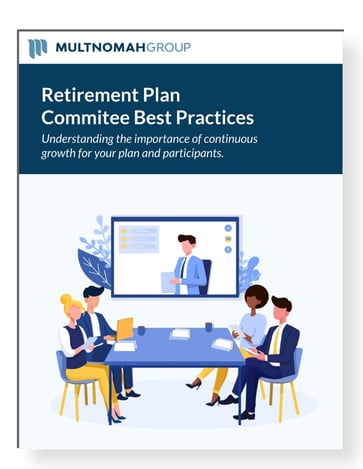In our first blog of this series focused on a committee's understanding of the importance of continuous growth for their retirement plan, we focused on ERISA's influence on fiduciaries and committees. Part 2 of this discussion focuses on understanding the historical models of retirement plan committees.
Committees come in all shapes and sizes, and under ERISA, there is no right or wrong answer. However, time and experience working with a variety of different organizations have shown that there are some ways of running committees that work better than others. Historically, plan sponsors have utilized the following structures to accomplish their fiduciary obligations:
- No committee: Today, less than 5% of plans do not have a committee[1]. Some committees might be quite small, but most plan sponsors have at least some committee in place, even if it is only a representative from human resources and a representative from finance. Those organizations not using a committee structure are either new plans, very small plans, or committees that are struggling with compliance and plan operations that would benefit from a committee structure.
- One committee: Approximately 64% of plans have one committee.[2] This committee typically varies widely in the number of individuals on the committee and includes various levels of experience and expertise related to the retirement plan. This committee is generally tasked via a committee delegation document such as a charter for all areas of responsibility related to the plan, including investments, vendor fees and services, employee engagement, and plan operations.
- Two or more committees: In some instances, larger plans break the responsibilities into two parts. One committee will handle the investment-related tasks while the other tasks are addressed by a second committee. In rare instances, there might be more than two committees.
Historically, these models had worked when the set of responsibilities and structures remained finite. In these cases, a charter or other delegation document was able to identify exactly what each committee was responsible for and where additional expertise was required. Where additional resources or expertise are needed, ERISA allows committees to hire experts.
These existing committee structures flourished in an environment where one or two members of the organization’s staff made outreaches to service providers as-needed with very little coordination and collaboration among all members in the benefits ecosystem.
These structures were not built for the complexity and interconnectedness that benefit structures require today. Consider:
- What happens when the committee(s) needs to be strategic across the entire benefits universe?
- How are longer-term benefits decisions for the organization made?
- How is the organization tracking whether participants can retire timely and with enough money for a sustained retirement
- How are the decisions in the retirement plan committee meeting impacting gender, income, and racial equity?
2020 brought about a change in how many organizations are showing up at work – for the retirement plan and beyond. This shift, coupled with the reasons described below, will help you understand why the historical committee models described above may need to be revisited for retirement plans to function efficiently and effectively in the coming years.
Our next blog in this series will focus on looking ahead to committees now and in the future and the primary drivers that influence the need to revisit committee structures and a changing governance program.
 To read our complete guide on this topic, "Retirement Plan Best Practices: Understanding the Importance of Continuous Growth for your Plan and Participants," click here.
To read our complete guide on this topic, "Retirement Plan Best Practices: Understanding the Importance of Continuous Growth for your Plan and Participants," click here.
Notes:
][1] See Plan Sponsor Council of America, Retirement Plan Committees, available at: https://www.psca.org/sites/psca.org/files/Research/2021/2021%20Snapshot_Ret%20Plan%20Com_FINAL.pdf.
[2] See id.
Multnomah Group is a registered investment adviser, registered with the Securities and Exchange Commission. Any information contained herein or on Multnomah Group’s website is provided for educational purposes only and does not intend to make an offer or solicitation for the sale or purchase of any specific securities, investments, or investment strategies. Investments involve risk and, unless otherwise stated, are not guaranteed. Multnomah Group does not provide legal or tax advice.

